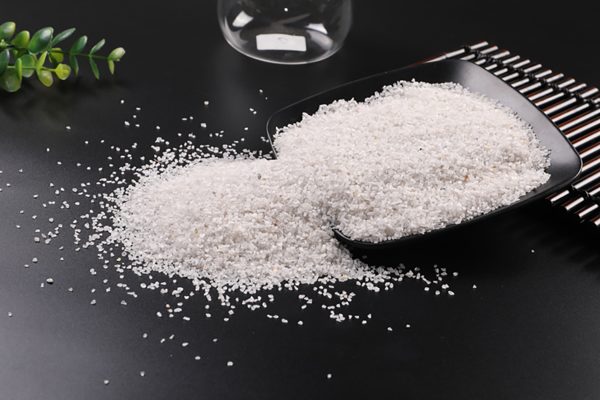
Quartz sand is widely used in many chemical industries such as water treatment and new building materials. In addition to the main component of silica, quartz sand also contains iron oxide, clay, mica and organic impurities, and there is generally a layer of molten iron on the surface of natural quartz ore to form a film. Compared with some fine industries that have strict requirements on iron content, when using quartz sand in production, it must be pickled to reduce the iron content in quartz sand. Pickling is mainly to eliminate the surface adsorption of quartz stone, the raw material of quartz sand, and diatomite carrier, and reduce the delamination of chromatographic peaks. The carrier needs to be pickled before production and processing. The production process of different types of quartz sand is very different. The following will introduce the production process of refined quartz sand and pickling quartz sand:
1. Purification and removal of impurities and pickling process of quartz sand, the raw material of quartz stone
1. Heat up to a certain temperature with a certain concentration of hydrochloric acid solution, and treat for 2-3 hours; the amount of hydrochloric acid is about 5% of the sand weight.
2. After washing the quartz sand with water, mix concentrated hydrochloric acid and sulfuric acid (98%) at the same time, let it stand at room temperature for 1-2 hours, or stir the mixed solution and quartz sand for a period of time to wash off the acid solution.
3. Treatment of oxalic acid and green vitriol: make water, oxalic acid, and green vitriol into a solution at a certain temperature according to the proportion, mix and stir the quartz sand and the solution according to a certain proportion, and treat it for a few minutes, then filter out the solution and treat it Recycled, the sand is washed, dewatered and dried.
4. Hydrofluoric acid treatment: Hydrofluoric acid treatment works best when applied alone, but requires a higher concentration. When used together with sodium disulfite, a lower concentration of hydrofluoric acid can be used.
5. Add a certain concentration of hydrochloric acid and fluosilicic acid solution to the quartz sand slurry at the same time; it can also be treated with hydrochloric acid solution first, and then treated with fluosilicic acid after washing with water; or turn Shunxun upside down and treat at high temperature 2-3 hours, then filter and wash.
2. The common production processes of refined quartz sand are: dry method and wet method
Quartz sand produced by dry method can usually be divided into three grades: ordinary quartz sand, semi-refined quartz sand and refined quartz sand. Because the surface of natural quartz stone is yellowish-brown, the finished product that is directly crushed and sieved from smaller quartz stone minerals is called ordinary quartz sand. The surface is yellowish-brown and white. , so it is mostly used in the construction industry; the semi-refined quartz sand is called semi-refined quartz sand after selecting larger quartz stone materials for processing. The surface is white, but dotted with yellow-brown spots. Wide range. Pick out large pieces of quartz ore, manually remove the yellow-brown skin on the surface, and then process it into refined quartz sand. The surface is white, shining like white sugar. Due to the time-consuming and material-consuming processing, the price is higher.
The main production equipment of the wet-process quartz sand production line includes jaw crushers, cone crushers (or fine jaw crushers, or impact crushers), quartz stone sand making machines, sand washing machines, dryers, etc.
3. There is only one common production process for pickling quartz sand: weak acid treatment
The production environment of pickling quartz sand is mostly in pure water or desalted water. First, it must be treated with weak acid. The reason why it needs to be treated with weak acid is that in the water system, there will be no qualitative change due to the content of certain substances in the water. The quality of quartz ore determines the concentration of hydrochloric acid and soaking time during pickling. The next step is crushing. The current quartz sand production equipment is integrated, and the ore enters the equipment and comes out as a finished product. But pickling quartz sand is not suitable for this kind of equipment, because after the ore is crushed, it cannot directly enter the vibrating screen, but enters the acid pool, so it is not suitable for integrated equipment. The concentration of hydrochloric acid is generally about 30%, and the best soaking time is about 24 hours. The soaked quartz sand has no impurities, and the color becomes crystal clear and white. Finally, it is sieved and rinsed. The sieving and rinsing are completed in one set of equipment. The quartz sand produced in this way is the best for reverse osmosis and desalination equipment.
Compared with pickled quartz sand, refined quartz sand needs to be calcined at 900 degrees, and then water quenching can make tiny cracks inside to facilitate pickling. It is crushed with ball mill or Raymond mill, and finally hydrochloric acid, hydrofluoric acid, sulfuric acid Mixing liquid pickling, soaking while stirring for 24 hours can achieve the purpose of pickling.
